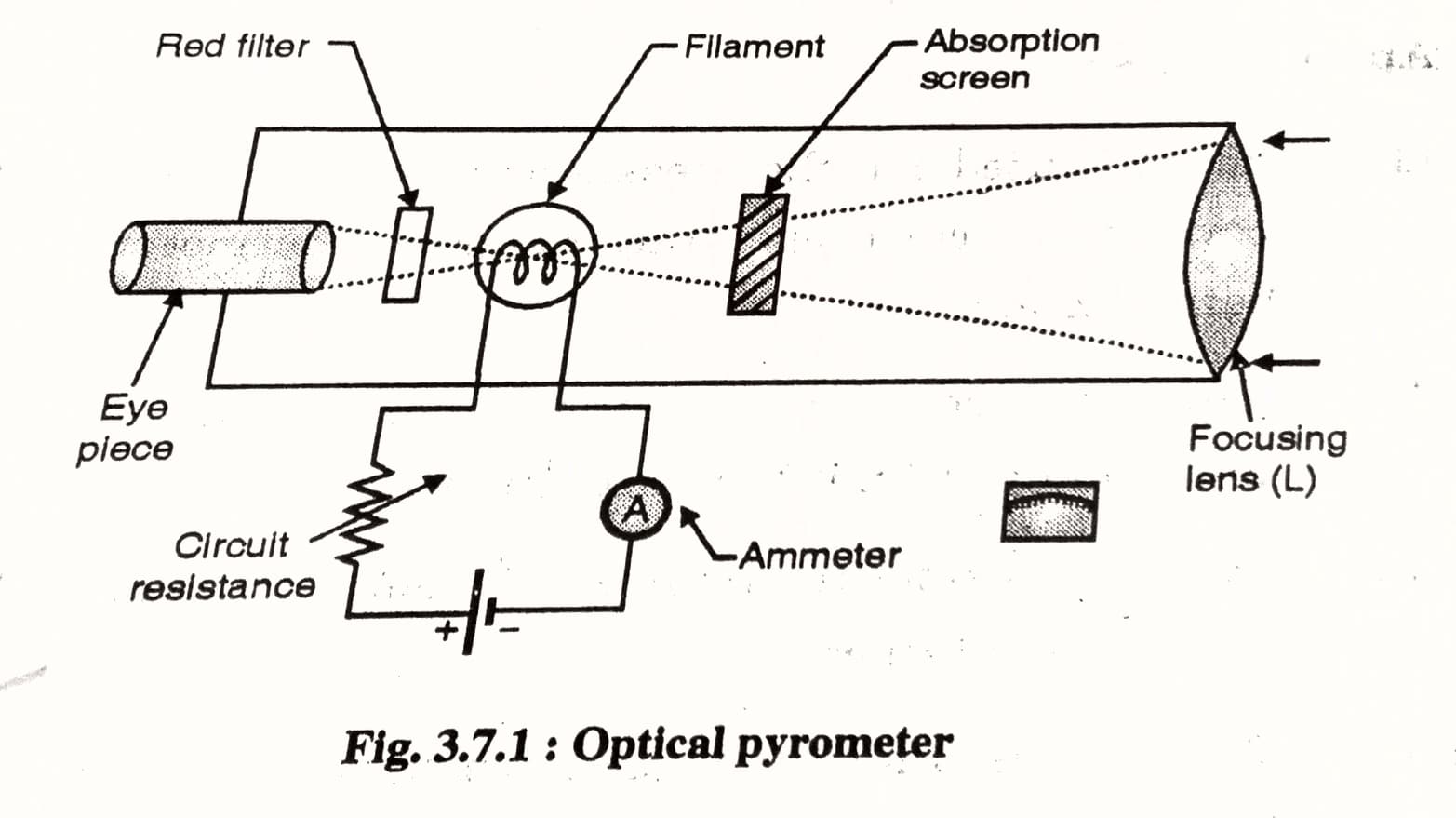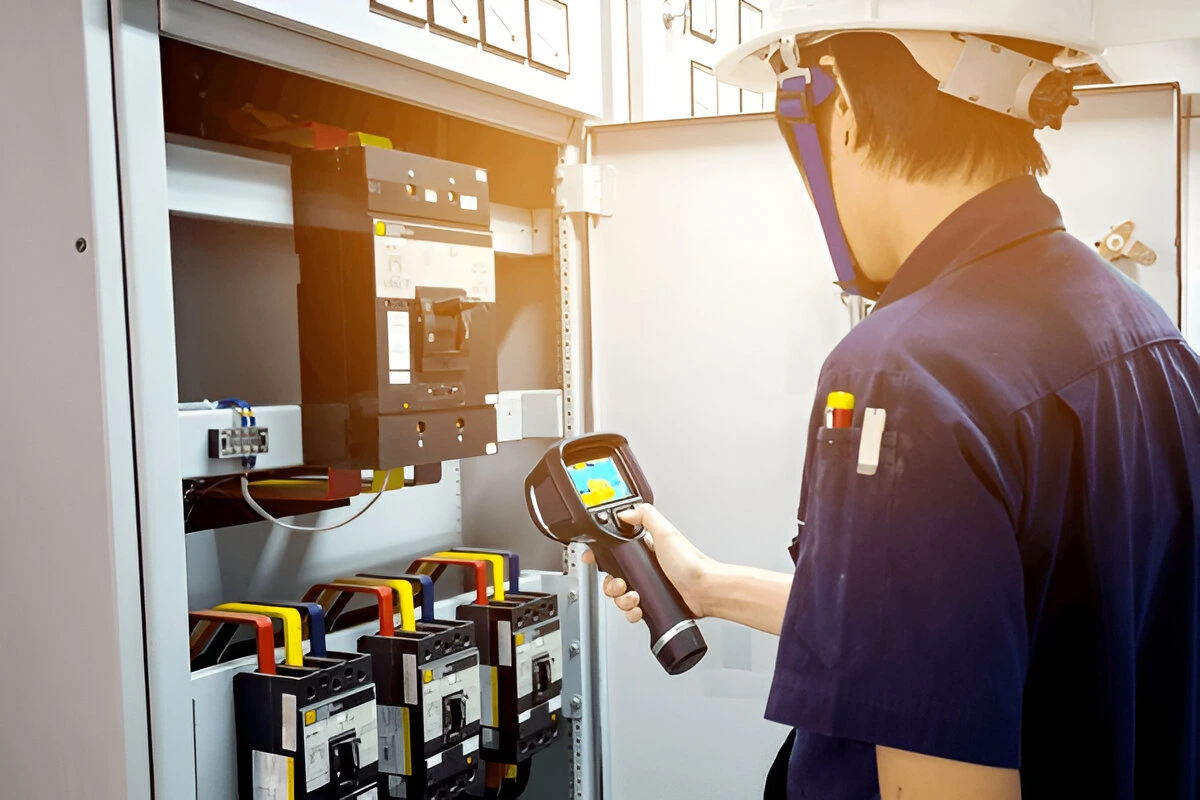
An optical pyrometer is a non-contact device that measures high temperatures by analyzing visible radiation emitted by hot objects. This tool is critical in industrial environments where direct contact with heated materials is impossible or unsafe, offering precision and convenience in temperature monitoring.
By leveraging the principle of incandescence, the optical pyrometer identifies the temperature by the brightness of glowing objects. This makes it ideal for metallurgy, glass, and steel manufacturing applications. Unlike contact thermometers, it ensures accurate temperature readings in extreme conditions, thus making it a preferred choice in many high-heat industrial processes.
What is an Optical Pyrometer?
An optical pyrometer is a temperature-measuring instrument designed to evaluate the thermal state of objects by comparing the brightness of a filament within the device to the brightness of the target object. It is often used in cases where the temperature exceeds the range of standard contact thermometers.
This tool works on the basic principle of matching visual radiation. The filament inside the device disappears when its brightness equals the object’s brightness, thus allowing an accurate temperature measurement.
Components of Optical Pyrometer
Eyepiece/Lens
The eyepiece enables the user to observe the filament and target object. It allows for precise filament alignment to the target, enhancing measurement accuracy. The lens is often adjustable to improve visibility and focus.
Battery
The battery powers internal electronics like the filament and the measurement circuit. It ensures portability and allows the device to function even in field operations. A reliable power supply is essential for accurate and stable readings.
Millivoltmeter
This component measures the voltage drop caused by the filament’s resistance change. The value shown corresponds to the target temperature. It provides the final temperature reading, usually calibrated in degrees Celsius or Fahrenheit.
Rheostat
A rheostat adjusts the current flowing through the filament. By modifying the brightness of the filament, users can match it to the target object. This component is crucial for obtaining the correct temperature match.
Temperature Bulb
It serves as a protective covering and helps stabilize the internal temperature sensors. It ensures a consistent internal environment for accurate readings. The bulb may also offer insulation against environmental fluctuations.
Absorption Screen
This screen reduces the intensity of radiation entering the device. It prevents glare and makes it easier to match filament brightness to the object. It’s advantageous when measuring extremely bright objects.
Objective Lens
The objective lens gathers light from the hot object and directs it onto the filament. It focuses on radiation to enhance clarity and measurement accuracy. A high-quality lens improves performance in low-light environments.
Red Filter
This filter only allows red wavelengths of light to pass through, minimizing errors due to varying spectral radiation. It enhances measurement consistency across different materials. The red filter is essential for precision in high-temperature observations.
Filament
Positioned at the center of the field of view, the filament is electrically heated and acts as the comparison point for the target object. When its brightness matches the object, the temperature is determined. It’s the core of the pyrometer’s functioning system.

Operating Principle of Optical Pyrometers
- Target Selection: The user selects a visible, incandescent object to measure, ensuring a clear line of sight to avoid reflection errors or obstruction.
- Viewing Through Eyepiece: Looking through the eyepiece, the user sees the object and a calibrated filament placed centrally in the field of view.
- Filament Heating: The filament is heated using a rheostat, increasing its brightness gradually while being visually compared to the target object.
- Brightness Matching: As the filament’s brightness approaches that of the target, it visually “disappears,” indicating that both are at the same brightness temperature.
- Reading Stabilization: Once the filament disappears against the background, the user stops adjusting the rheostat and waits a few seconds for the reading to stabilize.
- Temperature Display: The voltage corresponding to the filament current is measured by the millivoltmeter and converted into a temperature reading.
- Cross-Verification: In some high-precision tasks, the user may repeat the process to verify measurement consistency, especially in fluctuating environments.
- Recording and Application: Finally, the recorded temperature is noted and used for further processing or quality checks, which are critical in manufacturing workflows.
Applications of an Optical Pyrometer
Glass Manufacturing
In the glass industry, precise temperature control is essential to maintain consistency in texture and transparency. Optical pyrometers monitor furnace temperatures, helping prevent overheating or underheating. Their non-contact nature ensures accurate readings without risking equipment damage.
Steel and Rolling Mills
In steel production, the optical pyrometer measures the temperature of billets and slabs during rolling. This tool offers a reliable solution since direct contact is impractical in molten metal scenarios. Real-time readings help optimize process parameters and enhance product strength and quality.
Plastics and Polymer Industries
During the extrusion or molding process, plastic materials require specific heat thresholds. Using an ir pyrometer or optical pyrometer ensures these conditions are met without deforming the product. The device plays a vital role in temperature validation during high-speed production.
Electronics and Semiconductors
Semiconductor manufacturing involves sensitive thermal conditions where even a slight deviation can ruin entire batches. A pyro optical pyrometer enables precise control of wafer temperatures during fabrication. This improves yield rates and ensures defect-free chip production.
Pharmaceutical Manufacturing
Sterilization and high-temperature processes in the pharma sector demand exact thermal measurement. Optical pyrometers help monitor autoclaves and reactors without interfering with internal conditions. Their usage enhances safety and regulatory compliance.
Defense and Aerospace
In defense applications, components undergo extreme thermal tests. An optical pyrometer measures the temperature of engines, exhausts, and missile systems. It delivers real-time data critical for performance analysis and failure prevention in high-stakes environments.
Advantages of Using Optical Pyrometers
Non-Contact Measurement: Optical pyrometers do not need to touch the object, making them ideal for hazardous or extremely hot environments. This prevents wear and tear on the instrument and avoids contaminating the object.
High Temperature Range: These devices can measure temperatures up to 3000°C. This makes them suitable for industries like steel and glass, where temperatures far exceed conventional thermometer limits.
Quick Response Time: With almost instant readings, they allow real-time monitoring and control. This enhances the efficiency of heat-critical operations such as smelting or extrusion.
Accurate and Repeatable: Optical pyrometers deliver consistent readings even in challenging conditions. Their precision makes them indispensable in sectors requiring tight quality control.
Durability and Portability: Built to endure industrial settings, they are often lightweight and rugged. This makes them perfect for field usage without compromising on performance.

Difference Between Optical and Radiation Pyrometer
1. Principle of Operation
The optical pyrometer operates on the principle of visual brightness comparison. It involves manually adjusting the brightness of a filament until it visually blends with the target object, indicating matching temperatures.
In contrast, a radiation pyrometer (including an infrared pyrometer) measures the total thermal radiation emitted by the object using sensors, converting it directly into a temperature reading without manual visual comparison.
2. Spectral Sensitivity
Optical pyrometers function in the visible spectrum and are limited to measuring objects that emit visible light, typically those that glow red-hot or brighter.
Radiation pyrometers operate in the infrared region of the electromagnetic spectrum and can measure the temperature of both glowing and non-glowing objects, including cooler surfaces.
3. Accuracy and Application Suitability
Optical pyrometers are known for their high accuracy in measuring the temperature of incandescent bodies, especially in metallurgical and glass industries.
Though slightly less precise in brightness-specific scenarios, radiation pyrometers are more versatile. They can measure through dust, steam, or gases and are used across various environments and temperatures.
4. Automation and Ease of Use
Optical pyrometers require manual operation and user interpretation. The operator must align the filament and adjust the brightness for every measurement, which may introduce subjectivity.
Radiation pyrometers are typically automated, providing digital outputs and integration with control systems. They are easier to use in continuous monitoring and automated manufacturing setups.
5. Target Visibility Requirements
Optical pyrometers require a clear line of sight to the hot, glowing target for proper functioning. Any obstruction, such as smoke or dust, can interfere with the visual brightness match.
Radiation pyrometers, on the other hand, can still function reasonably well even when the view is partially obscured, thanks to their sensitivity to a broader range of thermal emissions.
Conclusion
An optical pyrometer is a specialized instrument that serves a critical function in industries where direct temperature measurement is impossible. Analyzing visible radiation delivers accurate and repeatable results, ensuring that industrial processes maintain quality and efficiency even in the harshest conditions.
Whether in steel mills, glass plants, or the aerospace sector, optical pyrometers continue to offer unmatched reliability and precision. If you’re looking for robust and dependable solutions, Manglam Electricals offers high-quality pyrometers tailored for diverse industrial needs. With a commitment to innovation and durability, Manglam Electricals ensures your operations run with thermal precision.

Leave a Reply